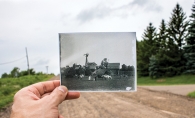There is a renewed spark of interest in the railroad among Minnesotans, with the expanding light-rail line and President Barack Obama’s February speech at the restored St. Paul Union Depot. But for some, like Woodbury’s Bill Schrankler, enthusiasm for trains and depots never waned.
Schrankler, a Woodbury Heritage Society board member and retired St. Paul Public Schools principal, released his first book, Shadows of Time… Minnesota’s Surviving Railroad Depots, in November 2013. The book is a compilation of stories and photographs of 168 train depots, including 53 that are listed on the National Register of Historic Places.
If you ask Schrankler what piqued his interest in depots, he’ll share a story about his mother. She arrived in Minnesota as a child aboard an “Orphan Train,” a supervised welfare program that relocated nearly 250,000 orphaned and homeless children from crowded eastern cities to rural Midwest communities from 1853 to 1929. She met her adoptive family when her train stopped at the Madelia, Minn. depot.
The Madelia depot was an integral part of Schrankler’s family history. “Visits to train depots became familiar, yet exciting events during the formative years of my life,” he writes in Shadows of Time. “It didn’t matter whether I was preparing to board a train for an eventful journey, or if my family took me there for arrivals and sendoffs. My memories of train depots are warm and vivid.”
Considering the stories Schrankler knew about the Madelia depot, he began to wonder about other Minnesota depots. That curiosity led him and his wife, Mary, on a 7,000-mile, three-year journey throughout the state, where they took nearly 5,000 photographs and uncovered the stories behind more than 200 railroad depots. Before long, Schrankler had enough material for a book. He asked Frederick Johnson, a former colleague and the author of eight Minnesota history books, to oversee the book’s historical accuracy, and another educator, David Thofern, to handle layout. The rest, as they say, is history.
During their travels, Schrankler was “surprised that many communities no longer knew where the depots were.” He and Mary were quick to discover “the best place to gather stories and information was in the town bars with the old timers, who knew the history and were happy to share.”
One of those stories features a North Redwood depot agent named Richard Sears, who received a train shipment of watches from Chicago. When the town jeweler rejected the delivery and the supplier refused to pay for shipping back to the city, Sears purchased the watches and began selling them out of Minnesota depots. Business grew and before long, he needed more watches and a business partner. When he moved to Chicago in the 1890s to open business with his new associate, Alvah Roebuck, Sears, Roebuck & Co. was born.
He also writes about Hinckley depot agent, Thomas Dunn, and The Great Hinckley Fire of 1894. As the fire approached town, Dunn used the telegraph to summon trains to help rescue citizens. Schrankler still becomes emotional when he recalls Dunn’s last transmission, which read, “I think I’ve stayed too long.” Hundreds of people died in that firestorm, including Dunn, but many more were saved. “To me, he is an unsung hero,” Schrankler says.
The book gives Schrankler “a fine sense of accomplishment and self fulfillment.” He says it is also a reminder of all of the people he and Mary met during their travels. “I was so impressed by the dedicated people who continue to preserve the depots.”
Interestingly, Bill says the railroad never came through Woodbury, “but this town always believed in partnering with neighboring communities and citizens—that spirit continues today.”
&
Shadows of Time is sold through area independent booksellers, train hobby shops and The Woodbury Heritage Society.









